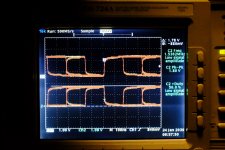Hey folks,
whilst soldering AES cables with XLR and stereo jacks as connectors I was wondering, if one should worry about the impedance of the connectors themselves. Or in other words is the effect of an impedance mismatch only dependent on the step in impedance or also on the length of transmission line for which the mismatch exists? Or: Do 2cm of mismatch do the same harm as 2 meters of mismatch (total length being equal) ?
I could not see much difference within 10% variation of the termination resistor, the AES standard is specified for +/-20% impedance I believe. But I have no idea what impedance a XLR connector or stereo jack and the alterations done to the cable might have.
I´m just asking out of curiosity, signal looks fine and all.
Many thanks
Ozo
whilst soldering AES cables with XLR and stereo jacks as connectors I was wondering, if one should worry about the impedance of the connectors themselves. Or in other words is the effect of an impedance mismatch only dependent on the step in impedance or also on the length of transmission line for which the mismatch exists? Or: Do 2cm of mismatch do the same harm as 2 meters of mismatch (total length being equal) ?
I could not see much difference within 10% variation of the termination resistor, the AES standard is specified for +/-20% impedance I believe. But I have no idea what impedance a XLR connector or stereo jack and the alterations done to the cable might have.
I´m just asking out of curiosity, signal looks fine and all.
Many thanks
Ozo
Attachments
Some 25 years ago people asked themselves the same question. They concluded it is the length of mismath that is important not so much the connector:
XLR's and AES/EBU impedance
XLR's and AES/EBU impedance
Whether the transmission line effect goes into play has to do with the signal's rate of transition, or rise/fall time tr, tf, and the length of the wire that the signal travels on. A rule of thumb is that, if it takes more than 1/6*tr for the signal to cover the length of a wire, one should start to watch out for transmission line effect. Say, for a signal that has tr at 5nS (typical of AES signals perhaps) travelling on a cable at 60% speed of light, the distance the signal propagates within 5/6 nS would be about 150mm. This is to say, if the geometric discontinuity (the connector) is less than 150mm in length there is not much to worry about in term of signal integrity for the signal at that rise time.
Last edited:
